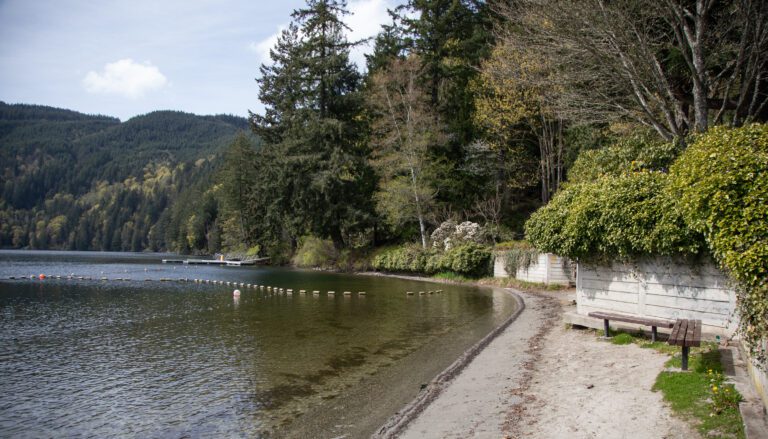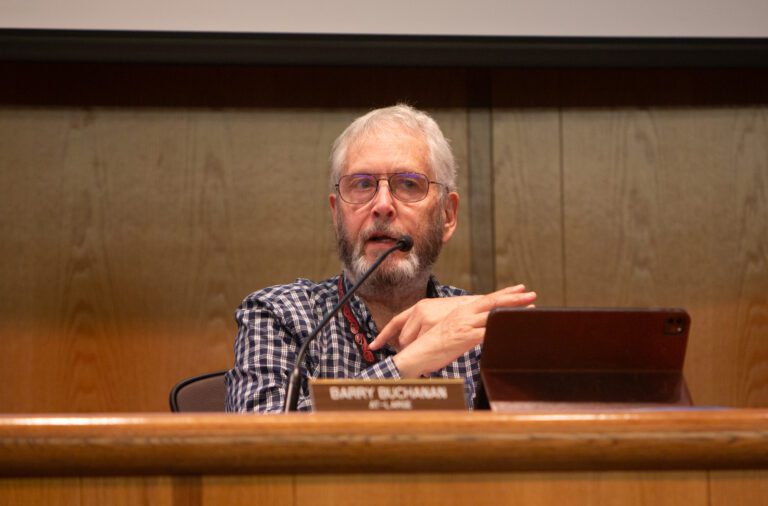Inside a private hangar at Bellingham International Airport, retired fisheries biologist Mike MacKay scrolls through photo albums on his iPad: wide-angle shots of Whatcom County’s shorelines; close-ups of fish-egg-covered eelgrass; photos of massive herring spawning events across Western Washington, documented with a GoPro mounted on the left wing of his hand-built airplane.
MacKay, 70, began documenting herring populations and spawning around Cherry Point for Lummi Nation Natural Resources in 1977, first as a passenger in a small Cessna-style plane and later as a pilot. After he retired a few years back, he picked up documenting the forage fish species near Cherry Point — at one point the most abundant herring stock in Washington waters, and unique for its late-season April and May spawning — in his own plane, which took him 11 years to build.
This year, for the first time, MacKay didn’t see any herring spawn in the waters of the Cherry Point Aquatic Reserve in April and May.
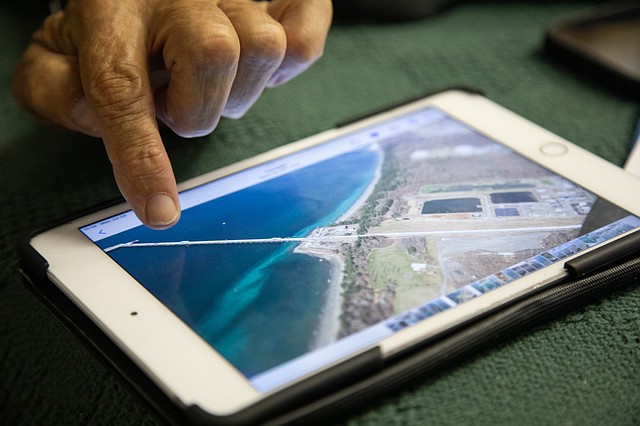 Mike MacKay points to herring spawns — the bright blue streaks — beneath the Phillips 66 refinery’s dock. MacKay took the photo while flying along the coastline with a GoPro attached to the wing of his plane. (Hailey Hoffman/Cascadia Daily News)
Mike MacKay points to herring spawns — the bright blue streaks — beneath the Phillips 66 refinery’s dock. MacKay took the photo while flying along the coastline with a GoPro attached to the wing of his plane. (Hailey Hoffman/Cascadia Daily News)
When he first started documenting it, the population was still large enough for fishermen to make some money off the season, and the fishery sustained young members of the Lummi Nation. The spawnings, he said, were major events.
“The whole horizon was dark with scoters, and it was so noisy because of the birds just everywhere,” he said with a smile. “There were gray whales around and up and down the shorelines and seals. There was just a lot of activity in the water. You could smell the spawn.”
In the almost 50 years he’s been tracking the small, silvery fish, he’s watched the local population plummet.
“The Cherry Point population was way, way larger, and had a higher biomass than any other population,” he said.
Volunteers like MacKay and employees at the Washington Department of Fish and Wildlife (WDFW) pay particularly close attention to the Cherry Point stock, and have monitored its population since it peaked at 13,606 tons of spawner biomass in the early 1970s.
Since then, the population has been in a near freefall, plummeting almost 100% between 1973 and 2022, according to WDFW’s data.
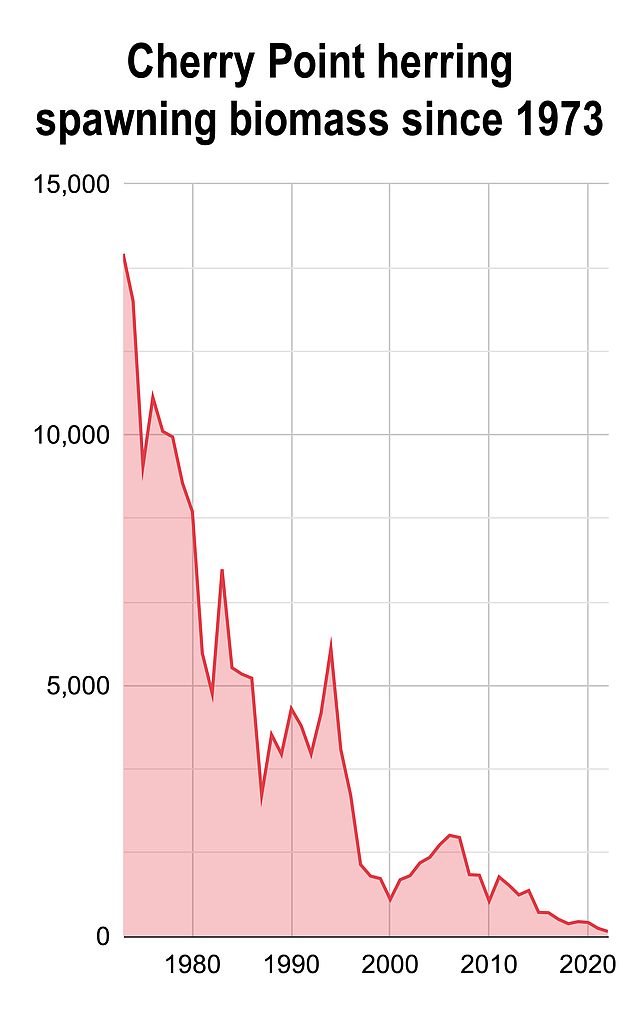 The state Department of Fish and Wildlife tracks spawning biomass totals for herring populations across Puget Sound. Between 1973 and 2022, DFW scientists found the spawning biomass total Cherry Point herring almost collapsed, from 13,606 tons in 1973 to 95 in 2022. This year, scientists reported no spawning near Cherry Point. (Julia Lerner/Cascadia Daily News)
The state Department of Fish and Wildlife tracks spawning biomass totals for herring populations across Puget Sound. Between 1973 and 2022, DFW scientists found the spawning biomass total Cherry Point herring almost collapsed, from 13,606 tons in 1973 to 95 in 2022. This year, scientists reported no spawning near Cherry Point. (Julia Lerner/Cascadia Daily News)
“The population has been declining, and has maybe collapsed,” MacKay said. “I hope not.”
Though the lack of spawn this year could just be an anomaly or due to natural population fluctuations, WDFW employees said, concerns remain about stock’s impact on other marine life. Already, there’s been a “marked decline” in seabirds like the once-common scoters — birds that feed on herring eggs before nesting — in the past two years as fewer herring spawn in the area, WDFW’s senior research scientist in forage fish research and management Phillip Dionne said in an email.
The extreme decline is abnormal, particularly as other local herring and forage fish populations flourish. WDFW tracks 21 separate spawning groups of herring, including the Cherry Point colony, and most have increased in recent years. Last year, researchers reported some of the highest amounts of spawning biomass since monitoring began in Sequim Bay and in the interior of the San Juan Islands.
Those concerns extend beyond birds and into other struggling populations, including threatened salmon and, higher up in the food chain, the region’s endangered Southern Resident killer whales.
In the coming months, WDFW will continue conducting surveys of the forage fish out at Cherry Point, as well as monitoring other nearby spawning populations, including in Fidalgo Bay and Semiahmoo Bay, where populations are growing.
Several theories exist about what happened to the fish. Dionne said it’s possible the fish spawned north of the U.S.-Canada border, where WDFW surveyors can’t track them. MacKay, though, has another theory: Cherry Point industries, including refineries and storage facilities for liquefied petroleum, may have had an impact on populations and overall herring health.
Discharge from the two refineries at Cherry Point — both of which have National Pollutant Discharge Elimination System permits from the United States Environmental Protection Agency (EPA) — can carry hydrocarbons like benzene or toxic metals like chromium, which contribute to fish deformation, illness and death.
Herring eggs are incredibly susceptible to toxins in the water, and once they’re laid in eelgrass along the shore, they’re completely immobile.
“Even small amounts of petroleum products can impact herring embryos,” said Eleanor Hines, the North Sound baykeeper and lead scientist for local environmental nonprofit RE Sources. “Even if they survive, they’re impaired and their overall fitness levels are decreased because they can have crooked backs or heart problems.”
When asked about discharge impacts on local herring populations, Phillips 66 said the refinery is committed to “environmentally responsible operations,” and said the industry is highly regulated to protect local, state and federal lands, according to Al Ortiz, a company spokesperson.
In the first year of operations in 1972, the BP refinery at Cherry Point — then owned by ARCO — reported spilling at least 20,000 gallons of crude oil during the spawning season, according to a petition to name Cherry Point herring an endangered species. Several similar petitions were filed around the same time, and all were declined by the federal government in 2005 and 2006.
Between 1972 and 2004, the two refineries reported more than 70 oil spills that could have potential impacts on the herring. That number jumped past 150 spills by 2010 according to a 2011 report from the EPA, though later data was not immediately available.
BP did not respond to a request for comment.
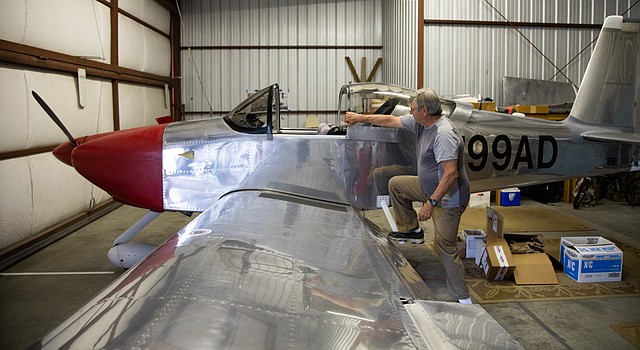 In a hangar at the Bellingham Airport, Mike MacKay climbs into his homemade airplane. (Hailey Hoffman/Cascadia Daily News)
In a hangar at the Bellingham Airport, Mike MacKay climbs into his homemade airplane. (Hailey Hoffman/Cascadia Daily News)
MacKay participated in several studies throughout his decades of tracking herrings, including a near-refinery survey in the 1990s that found some areas where roe were found were consistently exposed to toxins.
“During the first test, I think there was 98 percent abnormal larvae of approximately 300 individuals,” MacKay said. “And then when it was repeated the second time, it was almost 100 percent of about 300 eggs.”
Those surveys, he said, were definitive proof the near-shore water quality was impacting herring populations.
In the coming months, MacKay plans to keep flying over Cherry Point, watching for evidence of spawn. In the meantime, though, he’ll fly loops over Fidalgo Bay and the San Juan Islands to track the fish.
“This is a passion of mine,” he said. “I’ve been doing this for many years, and it’s something I can do with my airplane. I can cover a lot of ground in an hour.”
This story was updated Wednesday, July 26 at 3:11 p.m. to include the name of the Phillips 66 spokesperson.



